2026 Mazda BT-50 review
The Mazda BT-50 just got a double dose of updates! Barely had the dust settled from its earlier facelift this year, and Mazda’s already wrenching again. This time, it’s a serious upgrade aimed squarely at the workhorses of the road: fleets and tradies.
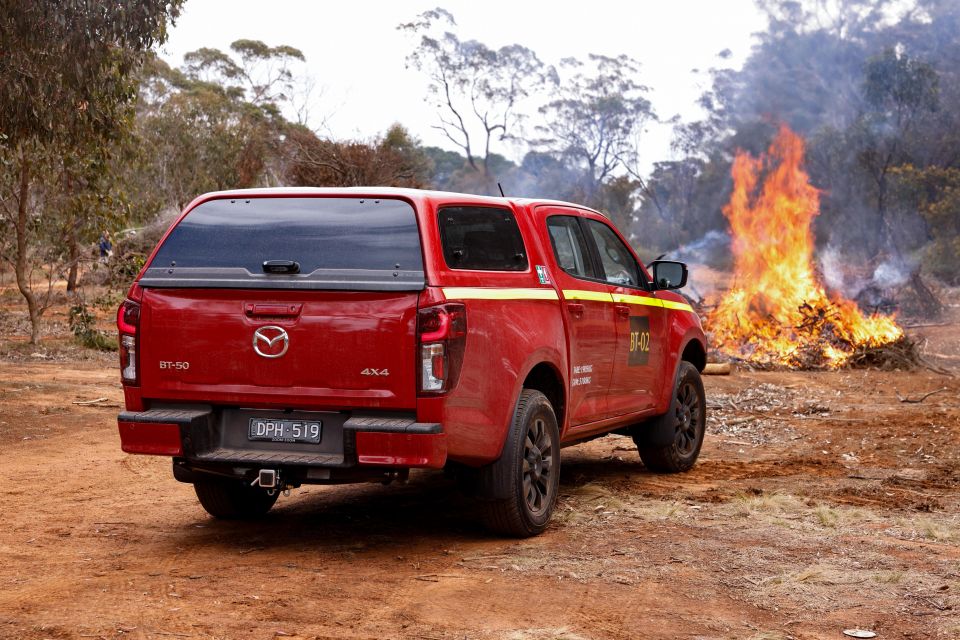
The Mazda BT-50 just got a heart transplant. Gone is the wheezy 1.9-liter turbo-diesel, replaced by a robust 2.2-liter unit. Think of it as a 300cc shot of adrenaline – landing almost in lockstep with the Isuzu D-Max, its platform sibling, which recently underwent the same vital upgrade.
The new entry-level turbo-diesel engine isn’t the only upgrade; an eight-speed automatic transmission now comes standard across all 4×2 and 4×4 configurations. But the real game-changer? The 2.2L engine is now available in single-cab/chassis, dual-cab/chassis,anddual-cab pickup styles – a massive leap from the previous 1.9L engine’s limited single-cab offering.
The revamped BT-50 now commands a higher entry price, a sting softened by the tantalizing prospect of superior towing prowess, thriftier fuel consumption, and an overall performance boost.
Dust swirled as Mazda unleashed its 2.2L BT-50s onto Victoria’s western landscapes. Paved roads gave way to gravel tracks, but the rugged terrain remained largely unchallenged. Only the double-cab variant graced the event. So, is this mild makeover enough to cure what ails the BT-50 in a crowded market?
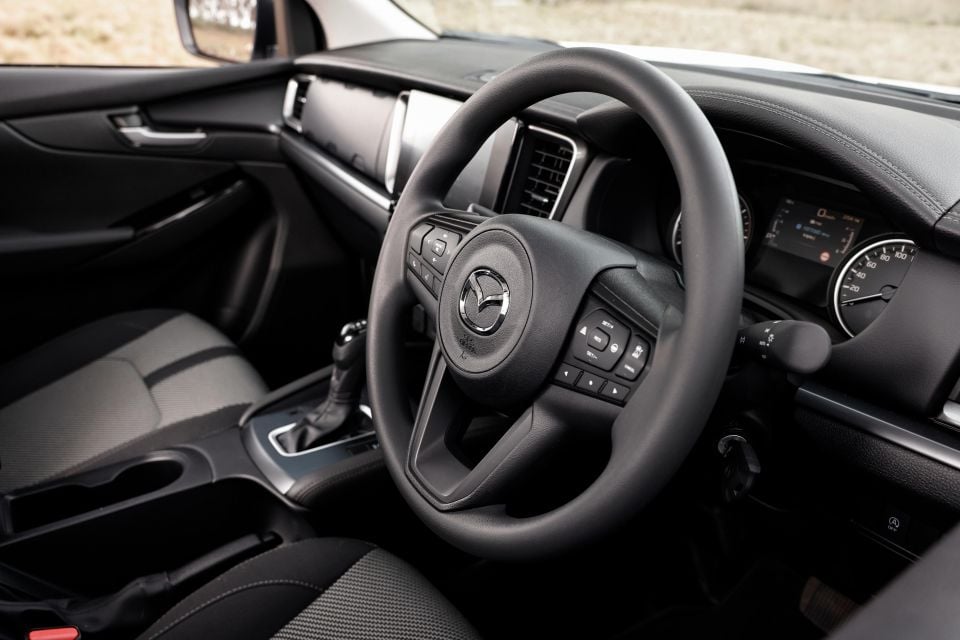
How much does the Mazda BT-50 cost?
The BT-50’s entry price just leaped. Trading up to the new 2.2-liter engine will cost you an extra $1500 compared to the outgoing 1.9-liter. That puts the keys to the most basic XS single-cab/chassis model at a hefty $37,900,beforeyou even factor in on-road costs.
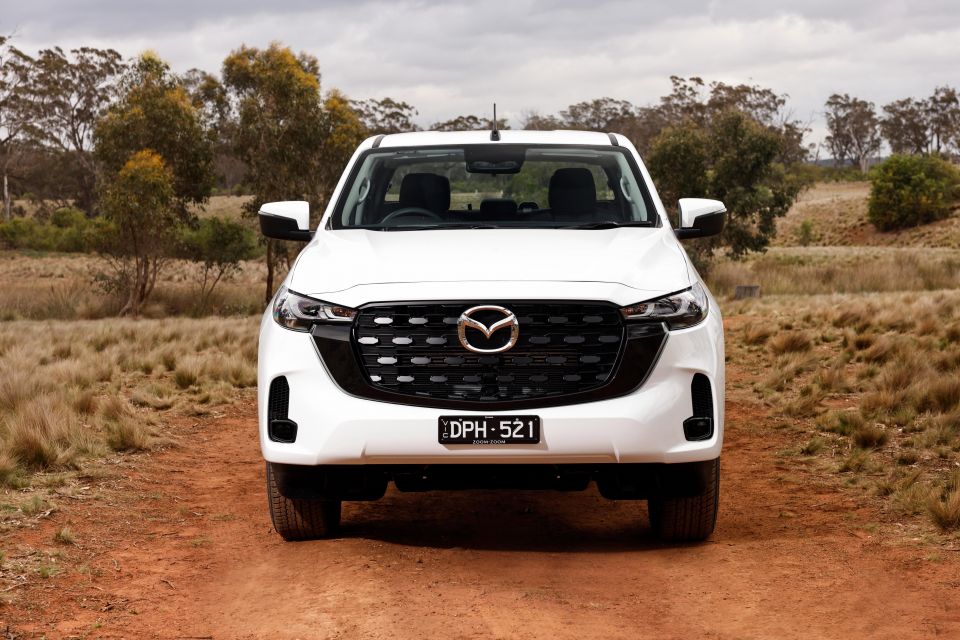
| Model | Price before on-road costs | | — | — | |2026 Mazda BT-50 XS 4×2 2.2L single-cab/chassis|$37,900| | 2026 Mazda BT-50 XT 4×2 3.0L single-cab/chassis | $40,400 | | 2026 Mazda BT-50 XT 4×2 3.0L freestyle-cab/chassis | $44,000 | |2026 Mazda BT-50 XS 4×2 2.2L dual-cab pickup|$46,710| | 2026 Mazda BT-50 XT 4×2 3.0L dual-cab/chassis | $47,610 | | 2026 Mazda BT-50 XT 4×2 3.0L dual-cab pickup | $49,210 | | 2026 Mazda BT-50 XT 4×4 3.0L single-cab/chassis | $48,250 | | 2026 Mazda BT-50 XT 4×4 3.0L freestyle-cab/chassis | $52,000 | |2026 Mazda BT-50 XS4×4 2.2L dual-cab/chassis|$53,120| | 2026 Mazda BT-50 XTR 4×2 3.0L dual-cab pickup | $54,240 | |2026 Mazda BT-50 XS 4×4 2.2L dual-cab pickup|$54,720| | 2026 Mazda BT-50 XT 4×4 3.0L dual-cab/chassis | $55,620 | | 2026 Mazda BT-50 XT 4×4 3.0L dual-cab pickup | $57,220 | | 2026 Mazda BT-50 XTR 4×4 3.0L dual-cab/chassis | $61,100 | | 2026 Mazda BT-50 XTR 4×4 3.0L dual-cab pickup | $63,200 | | 2026 Mazda BT-50 GT 4×4 3.0L dual-cab/chassis | $64,520 | | 2026 Mazda BT-50 GT 4×4 3.0L dual-cab pickup | $66,620 | | 2026 Mazda BT-50 SP 4×4 3.0L dual-cab pickup | $71,950 |
The Isuzu D-Max lurks as a budget-friendly alternative, particularly the single-cab/chassis model, clocking in at a tempting $36,200 (plus on-road costs). Even the 2.2-litre 4×2 pickup variants offer a compelling proposition, starting from $44,200 before you factor in on-road expenses, making it a serious contender for the cost-conscious buyer.
Want a Ford Ranger? The base 4×2 single-cab/chassis will set you back $37,130 (plus on-roads), but that’s with the 2.0-litre single-turbo diesel. Craving more power? Prepare to jump to $48,230 (plus on-roads) for the bi-turbo version of the same body style. The upside? You’ll be gripping the road with a 4×4 setup.
"Entry-level workhorses from Toyota and Mitsubishi – the HiLux and Triton – will set you back $32,970 and $34,740 (plus on-road costs), respectively. Suddenly, the BT-50’s price tag feels a bit…ambitious."
To see how the Mazda BT-50 stacks up against its rivals, use ourcomparison tool
Let us help you find your new car
Buy your new car without the stress. It’s fast, simple and completely free.

"Travis and his crew knocked it out of the park…again! This is the second time I’ve relied on their expertise, and honestly, I wouldn’t trust anyone else. Save yourself the hassle and give them a call – you won’t regret it."
Craig C.
Purchased a Ford Ranger in Sunshine Coast, QLD
childcareman.xyz helped Craig save thousands on his Ford Ranger, now let us save you on your next new car.
Find a deal
What is the Mazda BT-50 like on the inside?
Unsurprisingly similar to the D-Max, but with much less of the Mazda spice that makes its higher-spec models feel unique.

Say goodbye to the SP’s sophisticated black and terracotta, and the GT’s practical black synthetic leather. The XS model? It’s a sea of familiar cloth. Forget bespoke stitching or a unique dash; it’s a direct transplant from the D-Max, leaving little to ignite the senses.
Isuzu’s interior prioritizes function, a no-frills approach mirrored in the Mazda. Though comfortable enough, a palpable sense of unbreakable toughness permeates the cabin, a reassuring promise of resilience.
Everywhere you look, it’s a plastic wasteland. The door cards are drab, the steering wheel feels like a toy, and the climate control and infotainment display offer the bare minimum in terms of visual flair and tactile pleasure. The cabin screams austerity.
The BT-50’s 8.0-inch infotainment screen, found in this and the XT trim, is a direct transplant from the D-Max, right down to the pixel-perfect user interface. Thankfully, unlike some purely touchscreen systems, Mazda hasn’t abandoned physical controls; isolated touch shortcuts and tactile knobs offer a welcome alternative to jabbing at the screen while on the move, a feature shared with its bigger, 9.0-inch brother.

Glanceable icons provide quick, on-the-go navigation, yet the home screen’s large native app icons remain boldly legible. Isuzu’s penchant for rugged practicality persists with default off-road menus, a visual echo of their utilitarian design ethos.
Even the entry-level model boasts wireless Apple CarPlay and Android Auto – a welcome addition introduced with the BT-50’s 2025 refresh, bringing cutting-edge connectivity to every driver.
The instrument cluster? That’s where the XS whispers its true identity. Forget the dazzling 7.0-inch display flaunted by the XTR and above. In the XS (and XT), you’re greeted by a classic duo: old-school analogue gauges flanking a humble 4.2-inch LCD screen. It’s a vintage vibe meets modern necessity – a gentle nudge reminding you this is the entry-level experience.
The gauges, clean and uncluttered, echo the ute’s bare-bones spirit, a design harmony that’s quietly satisfying. A small screen, seamlessly integrated, offers just enough information. Steering wheel controls allow you to surf a couple of essential menus.

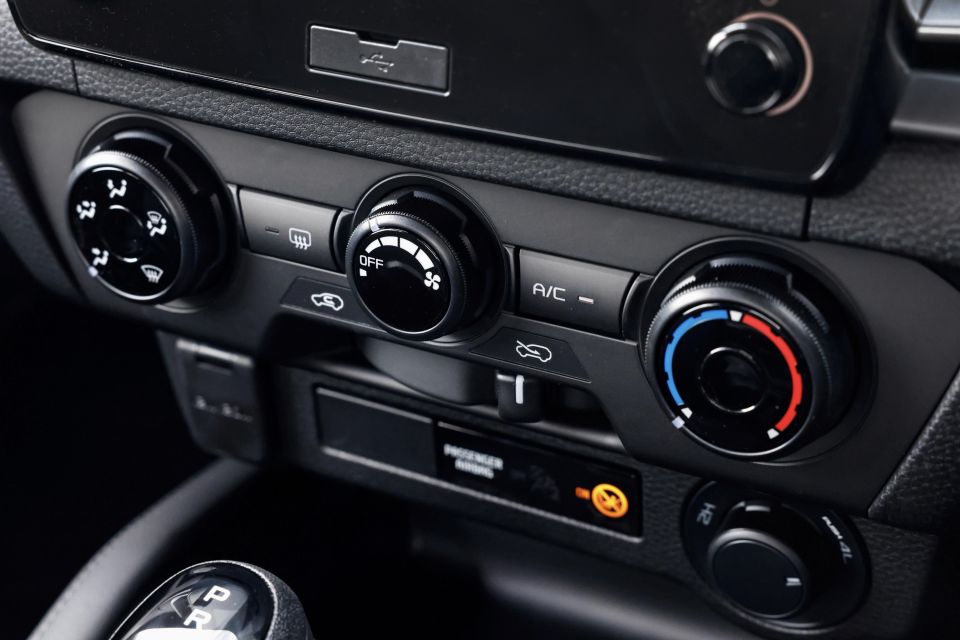
Forget the supple leather and polished silver – this steering wheel is a study in stark practicality. Your hands meet cold, unyielding polyurethane, a no-frills experience in a sea of black plastic. It’s a direct connection to the road, where luxury takes a backseat to raw functionality. You might not swoon, but you’ll certainly steer.
The XS interior embraces utilitarian chic, right down to the matte black plastic of the control buttons. This understated finish extends to the center console, framing the gear selector and housing off-road settings. Notice the subtle, almost teasing blank spaces? A hint of luxury omitted, where heated seat controls would usually reside, a constant reminder of pure functionality.
Forget fancy climate control systems. Isuzu sticks to a reliable, no-nonsense three-dial setup. It’s built for the grind, unlike those needlessly complex, button-laden systems in pricier trucks. The only real downside? You’ll be hunting for extra storage.
Forget fancy coffee runs. While it boasts the usual stash spots – cupholders, a tiered glovebox, and a console bin – this workhorse surprisingly skips some clever storage tricks. No D-Max-inspired dashboard cubby. No Ranger-esque, dash-mounted cupholder oasis. Tradies, prepare to get creative with your caffeine and clutter.
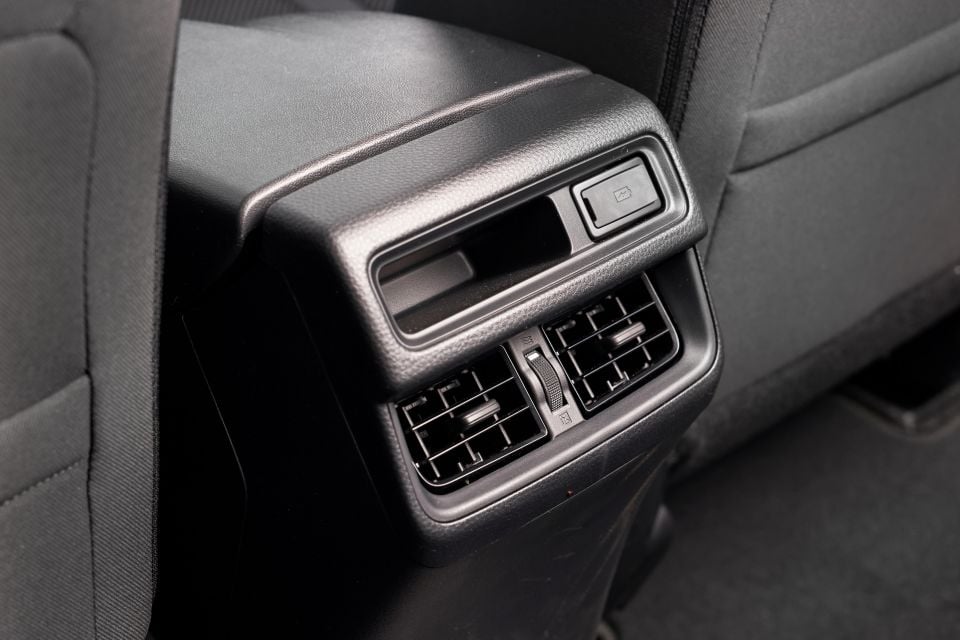
The back seat? Roomy, despite appearances. Legroom won’t be an issue. Passengers get their own air vents and a USB-C port, though the centre armrest and extra cupholders are MIA – door pockets are your only option for drinks.
"The cabin echoes the price point, a gentle reminder that budget-friendly comes with strings attached. While not deal-breakers, the restrictions on customization and configurations nibble away at the adventurous spirit you’d expect from a base-model BT-50 ute. And in this age of ubiquitous charging needs? Just a single USB-C port. Choose your device wisely."
The rear seats are a utilitarian afterthought – a realm strictly for passengers, devoid of any pampering. Need cargo room instead? The seat cushions cleverly flip up, unveiling a secret stash of hidden compartments.
Of course, none of that is applicable to the two-seat, single-cab/chassis variants.

The BT-50 XS offers a choice: a no-nonsense alloy tray or a classic pickup tub. Forget frills; these are built for graft. Stripped back? Maybe. But for a workhorse designed to earn its keep, that’s precisely the point.
Say goodbye to the tailgate slam! Our pickup trucks boast hydraulic tailgate assistance, gently easing the tailgate down with controlled grace. Lowering has never been smoother. Closing it, however, still requires a bit of muscle.
Pickup models also lack a standard tonneau cover, a crucial feature for tradies hauling tools. While manufacturers often leave these as optional extras, thankfully, a bed liner comes standard.
"Though exact tray dimensions remain elusive, the tub itself stretches out a hair longer than the average rival, offering that little bit of extra wiggle room others skimp on."
| Dimensions | Mazda BT-50 single-cab/chassis | Dual-cab/chassis | Dual-cab pickup | | — | — | — | — | |Length| 5320mm | 5280mm | 5280mm | |Width| 1870mm | 1870mm | 1870mm | |Height| 1790mm | 1800mm | 1785mm | |Wheelbase| 3125mm | 3125mm | 3125mm | |Tub length| – | – | 1571mm | |Tub width (between wheel arches)| – | – | 1120mm | |Tub depth| – | – | 1530mm |
To see how the Mazda BT-50 stacks up against its rivals, use ourcomparison tool
What’s under the bonnet?
The real story lies beneath the hood: a potent 2.2-liter turbo-diesel heart now beats within. Unleashing a robust 120kW and a formidable 400Nm of torque, it’s a noticeable surge from the previous 1.9-liter – think of it as adding a shot of adrenaline, a healthy 10kW and 50Nm, to an already capable machine.
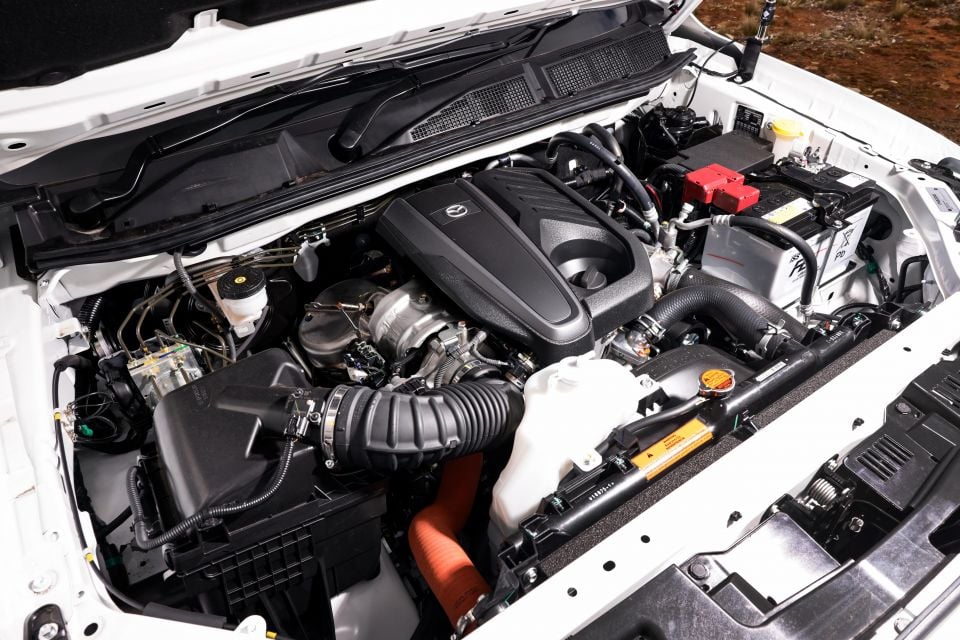
| Specifications | Mazda BT-50 XS | | — | — | |Engine| 2.2L 4cyl turbo-diesel | |Power| 120kW | |Torque| 400Nm | |Transmission| 8-speed auto | |Drive type| Rear-wheel drive or four-wheel drive with low range | |Fuel economy (claimed)| 6.3L/100km (4×2 dual-cab pickup) 6.6L/100km (4×4 dual-cab pickup) 6.9L/100km ( 4×2 single-cab/chassis) 7.1L/100km (4×4 dual-cab/chassis) | |Fuel economy (as tested)| | |CO2 emissions (claimed)| 167g/km (4×2 dual-cab pickup) 174g/km (4×4 dual-cab pickup) 183g/km (4×2 single-cab/chassis) 188g/km (4×4 dual-cab/chassis) | |Fuel tank| 76L | |Kerb weight| 1787kg (4×2 single-cab/chassis, with standard alloy tray) 1888kg ( 4×2 dual-cab pickup) 1961kg ( 4×4 dual-cab pickup) 1966kg ( 4×4 dual-cab/chassis, with standard alloy tray) | |Payload| 1112kg ( 4×2 dual-cab pickup) 1134kg ( 4×4 dual-cab/chassis, with standard alloy tray) 1139kg ( 4×4 dual-cab pickup) 1213kg ( 4×2 single-cab/chassis, with standard alloy tray) | |Braked towing capacity| 3500kg | |Gross vehicle mass (GVM)| 3000kg ( 4×2) 3100kg ( 4×4) | |Gross combination mass (GCM)| 5500kg ( 4×2) 6000kg ( 4×4) |
Forget rowing your own gears – this beast boasts an eight-speed automatic transmission, leaving the six-speed in its 3.0-liter sibling eating dust. Choose your own adventure: a rear-wheel-drive thrill or the tenacious grip of four-wheel drive, complete with low-range gearing for conquering the untamed.
Fuel economy? Slippery subject. Mazda’s local launch barely gave us enough wheel time to scratch the surface. But a fleeting glimpse at the numbers suggests you might see around 7.5L/100km in the real world. Take that with a grain of salt, though – a proper test drive is definitely needed to confirm.
To see how the Mazda BT-50 stacks up against its rivals, use ourcomparison tool
How does the Mazda BT-50 drive?
The refreshed BT-50 impressed me earlier this year, marred only by a few niggles that felt out of sync with its overall refinement. Surprisingly, in the XS trim, those imperfections become almost…invisible.
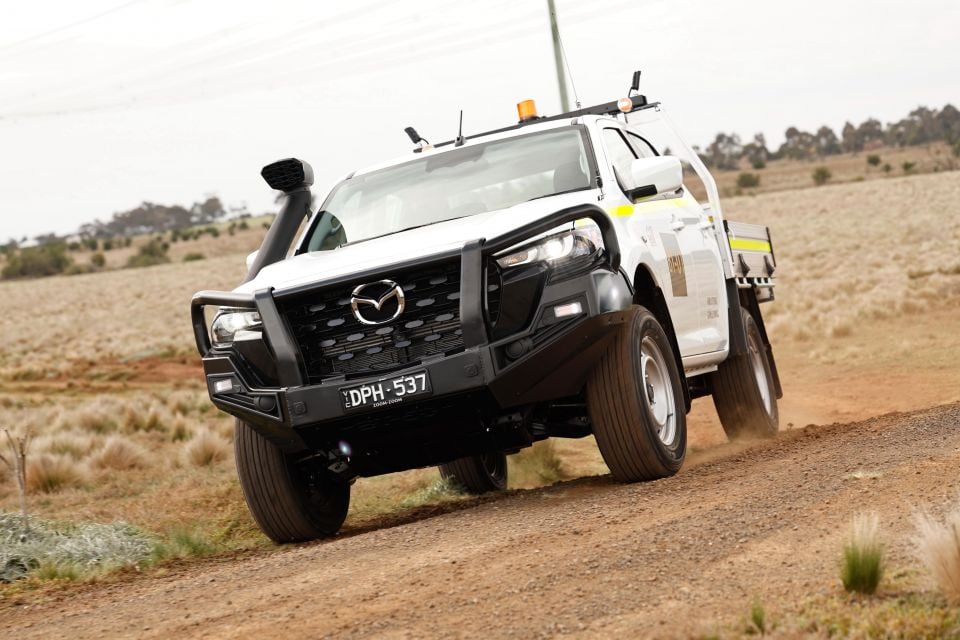
Okay.
True, those quirks remain, but now they feel less like flaws and more like character traits befitting a workhorse. It still leans into corners like a sailor on shore leave, and the new engine, while present, doesn’t exactly launch you off the line.
Forget scorching lap times. This machine is built for endurance, not fleeting glory. Its factory tires are tireless nomads, designed to devour thousands of kilometers across unforgiving terrains and demanding worksites, all while clawing through to the most remote and challenging destinations.
Its slight instability adds an element of playful recklessness fling it around a bit! Forget tiptoeing on gravel roads; the BT-50 shrugs them off. And with a dizzying array of accessories, you can fine-tune this beast to conquer any task you throw its way.
The new engine? Let’s just say it’s less a rocket and more a… well, it still feels like you’re waiting for a bus. Don’t expect a thrilling departure from the old 1.9-litre’s leisurely pace.
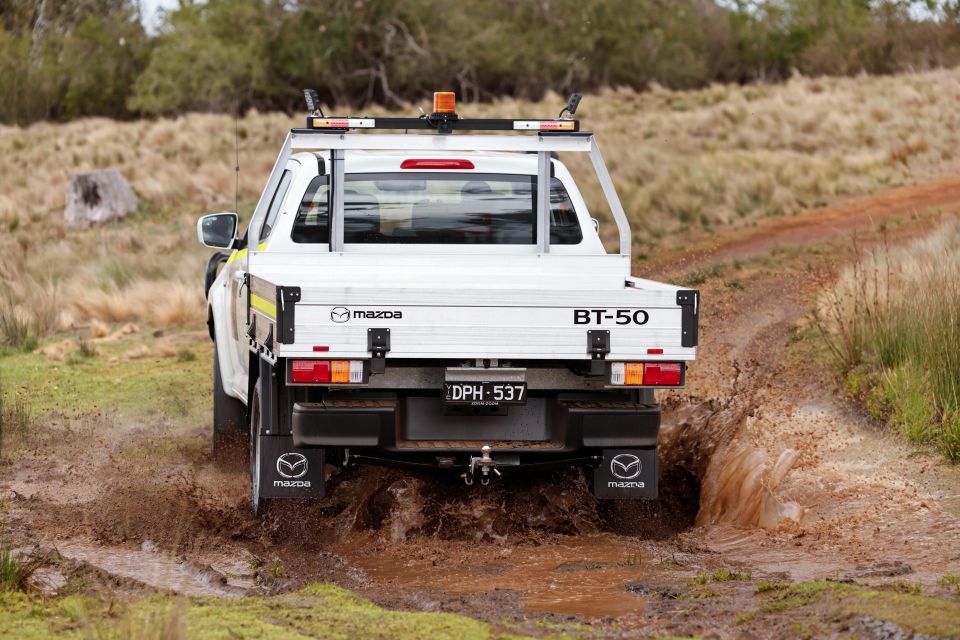
The 2.2-liter engine won’t win any drag races, especially when stacked against its beefier 3.0-liter sibling. However, it’s no longer the embarrassing slowpoke it once was. Recent tweaks have nudged it into the realm of "agreeably sluggish," a place where expectations meet reality, and drivers rarely demand more than it offers.
The engine doesn’t gasp for air like the old 1.9L. Instead, a confident diesel rumble fills the air as it steadily gains momentum, hitting highway speeds with purpose. Inside, the world fades away. Conversations flow easily, undisturbed by the engine’s song or the road’s hum.
The old six-speed is out; a silky-smooth eight-speed automatic now manages power delivery. While there’s still a heartbeat of hesitation when you bury the throttle, it’s only a fleeting pause before the engine unleashes its fury. Drive it like a saint, and you’ll barely notice. Drive it like a sinner, and even then, it’s easily forgiven.
Forget everything you think you know about driving a ute. This one is different. Where the 1.9 might inspire dread, this one delivers a surprisingly pleasant experience. It’s not going to win any races, but it packs enough punch to keep you out of trouble. Overtaking requires a bit of foresight, granted, but switch to 2H on a dirt road, and you can still coax it into a tire-smoking dance at speed. Fun, right?
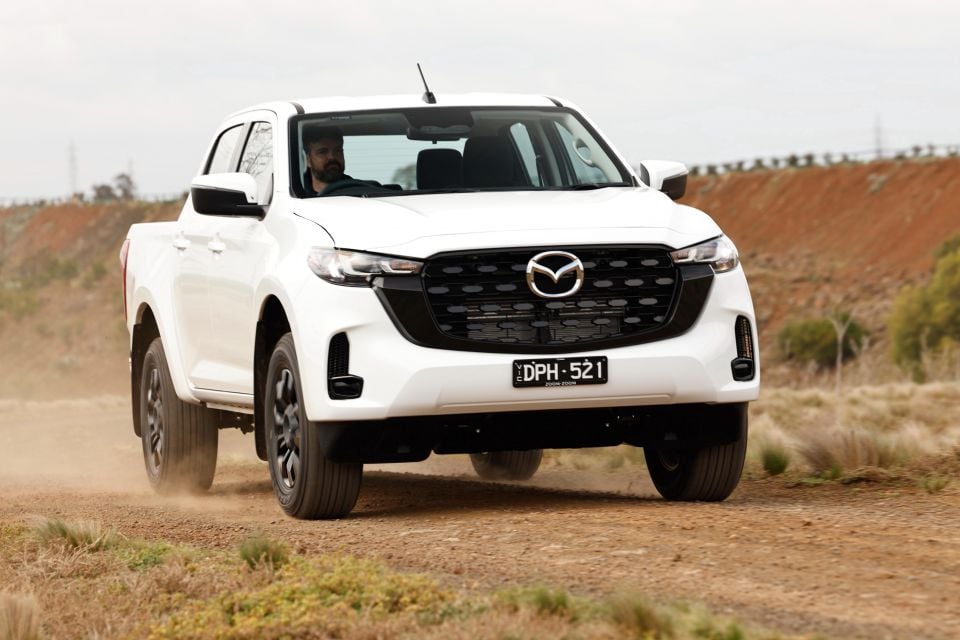
Beyond its rugged good looks, the four-wheel-drive model packs a secret weapon: a low-range gear box. Cruise the city streets in fuel-sipping rear-wheel drive, then, when adventure calls and the asphalt ends, unleash the beast with a flick of a switch, transforming into a go-anywhere 4×4 conqueror.
Even empty, the ride is surprisingly refined. It maintains its composure remarkably well, and while it won’t dethrone the Ranger’s ride supremacy, long journeys remain a comfortable prospect.
Forget bone-jarring bounces! Unlike lesser Tritons, whose stiff rear leaf springs turn every bump into a rodeo for your passengers, the BT-50 offers a noticeably smoother ride. While not exactly cloud-like, it’s civilized enough to keep backseat gripes to a minimum, even on less-than-perfect pavement.
The BT-50’s 2.2-litre engine? Think ‘reliable workhorse,’ not ‘fire-breathing stallion.’ It’s a dependable engine that gets the job done, but don’t expect to be blown away.
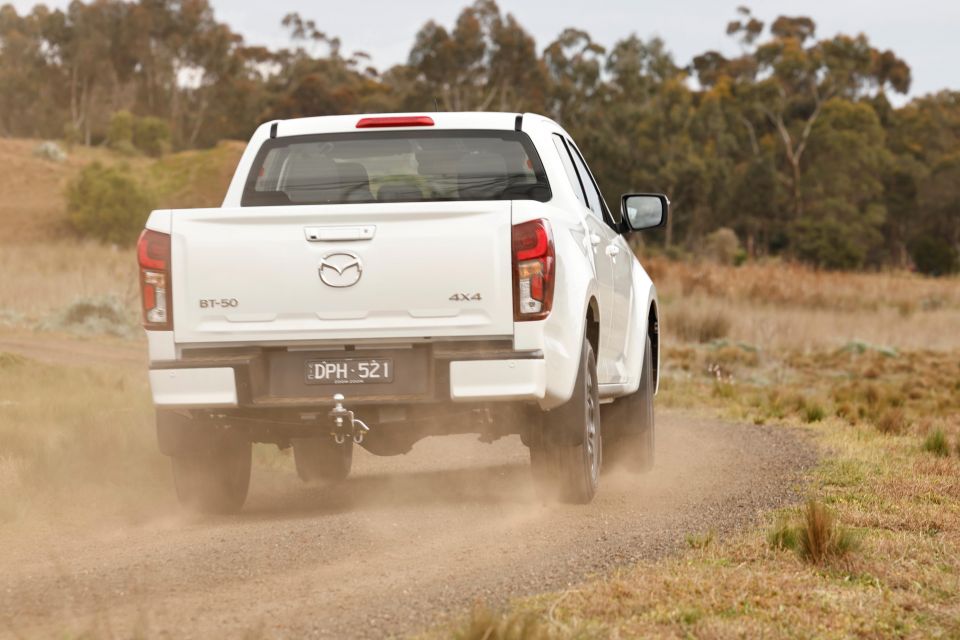
Trusted Reviews, Smarter Choices, Better Prices
Stop dreaming, start driving. Childcareman.xyz isn’t just car reviews; it’s your personalized roadmap to new car savings. Expert advice, tailored service, and unbeatable deals – all in one place. Find your perfect ride today!
View showroom
Compare cars
Find a deal
Finally, experience nimble handling in close quarters, amplified by a confident, elevated driving position that offers an unrivaled, panoramic perspective.
Rear visibility is decent, though typical ute quirks persist. The tub, as expected, can swallow up smaller objects or those lurking close to the bumper. Interestingly, tray-equipped models offered a clearer view compared to our experience with the Triton, where similar obstructions were more pronounced.
The 3.0-litre BT-50 confidently tackles off-road challenges. While the 2.2L models at the launch weren’t pushed to their limits in four-wheel drive, their shared DNA suggests they’ll exhibit similar prowess when the pavement ends.
Forget the symphony of beeps and bongs some reviewers complained about in the BT-50. During our time behind the wheel, the cabin remained blessedly silent. The result? A refreshingly simple and intuitive driving experience – a win for seasoned ute drivers and newcomers alike.
| Off-road dimensions | Mazda BT-50 XS | | — | — | |Track front and rear| 1570mm | |Ground clearance| 235mm | |Approach angle| 29.6º (cab/chassis) 30.0º (dual-cab pickup) | |Departure angle| 24.6º (single-cab/chassis) 29.6º (dual-cab/chassis) 23.9º (dual-cab pickup) | |Ramp breakover angle| 23.9º (cab/chassis) 23.3º (dual-cab pickup) | |Wading depth| 800mm |
To see how the Mazda BT-50 stacks up against its rivals, use ourcomparison tool
What do you get?
The five-grade BT-50 model range is unchanged.


2026 Mazda BT-50 XS equipment highlights:
- 17-inch steel wheels
- LED headlights
- Black cloth upholstery
- Vinyl floor covering
- Air-conditioning
- Power windows
- Rain-sensing wipers
- 7.0-inch instrument cluster screen
- 8.0-inch infotainment touchscreen
- Wired and wireless Apple CarPlay, Android Auto
BT-50 XT adds:
- 17-inch alloy wheels
- Rear air vents (pickup only)
- Tailgate assist
- Rough terrain mode (4×4 only)
- Locking rear differential (4×4 only)
BT-50 XTR gains:
- 18-inch machined alloy wheels
- LED front fog lights
- Auto-levelling LED headlights with daytime running lights (DRLs)
- Power-folding exterior mirrors
- Side steps
- Tow bar with receiver, tongue and wiring harness (pickup only)
- Tub liner (pickup models only)
- Leather-wrapped steering wheel
- Leather-wrapped gear selector
- Dual-zone climate control
- 9.0-inch infotainment touchscreen
- Satellite navigation
- Advanced keyless entry
BT-50 GT adds:
- Heated mirrors
- Black leather seats
- Eight-way power-adjustable driver’s seat
- Heated front seats
- Remote engine start
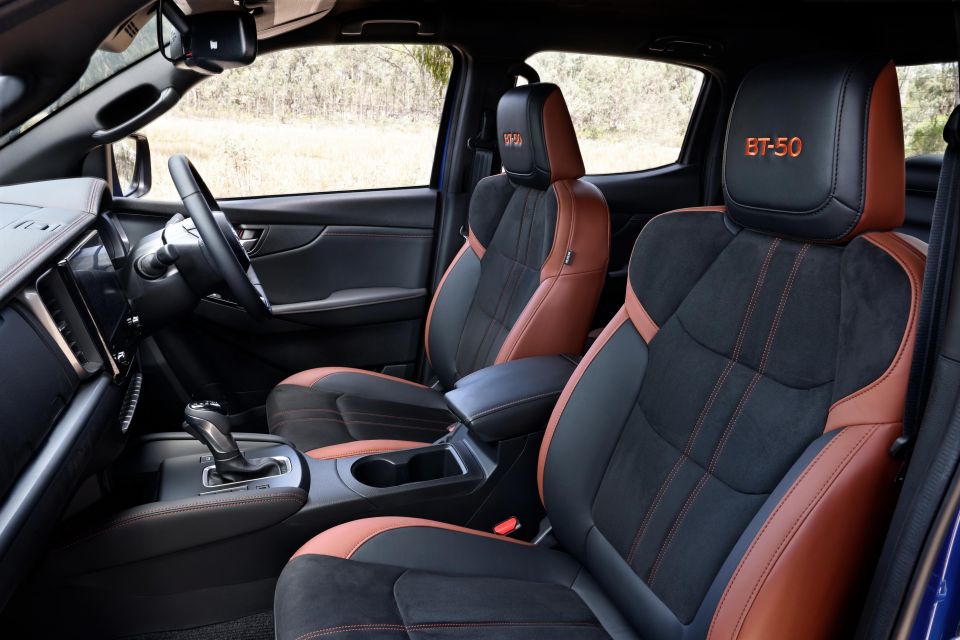
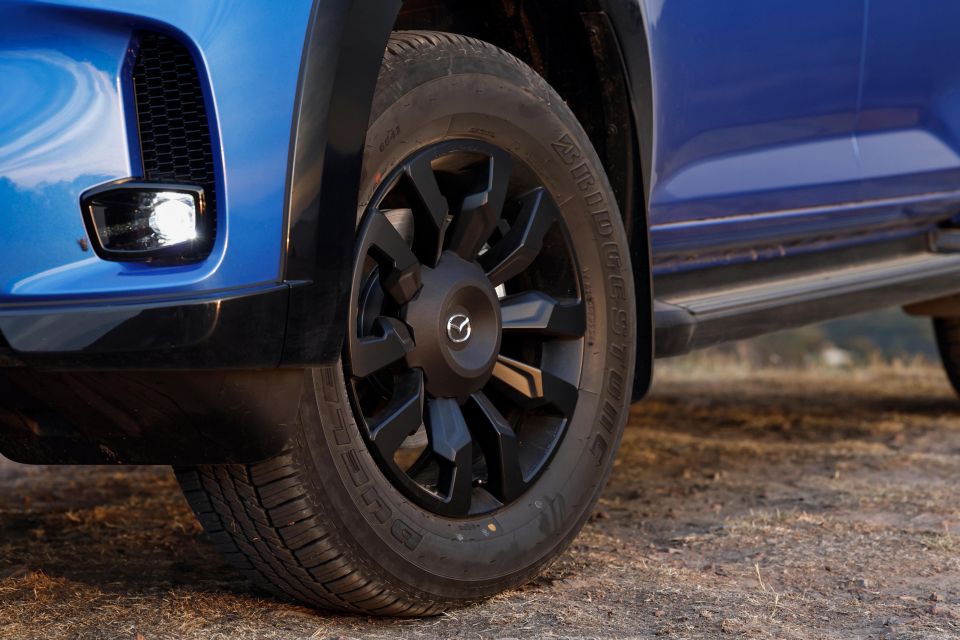
BT-50 SP
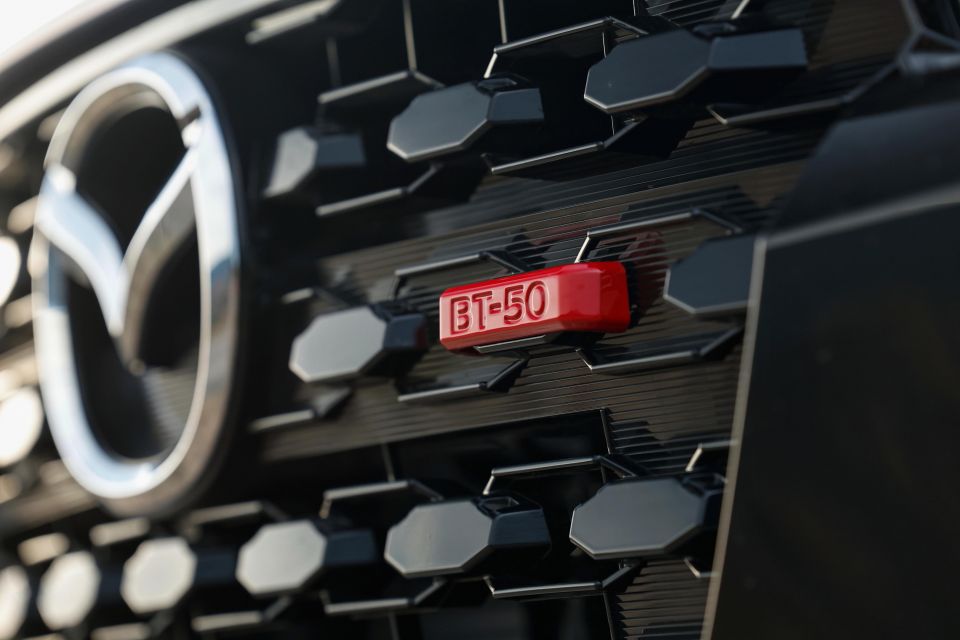
BT-50 SP gains:
- 18-inch gloss black alloy wheels
- Gloss black exterior highlights
- Sail plane sports bar
- Side steps
- Wheel-arch flares
- Roof rails
- Mirror caps
- Door and tailgate handles
- Manual roller tonneau cover
- Black and terracotta ‘Maztex’ and suede upholstery
Unleash the full potential of your BT-50 with Mazda’s genuine accessories. With over 100 options to choose from, a visit to your local Mazda dealer could be the key to unlocking a truly personalized ride.
Protect your investment with peace of mind. Accessories installed right at delivery enjoy the full five-year factory warranty. Adding them later? You’re still covered with a solid two-year warranty.
To see how the Mazda BT-50 stacks up against its rivals, use ourcomparison tool
Is the Mazda BT-50 safe?
The Mazda BT-50 boasts a five-star ANCAP safety rating, based on testing conducted on the D-Max in 2022.
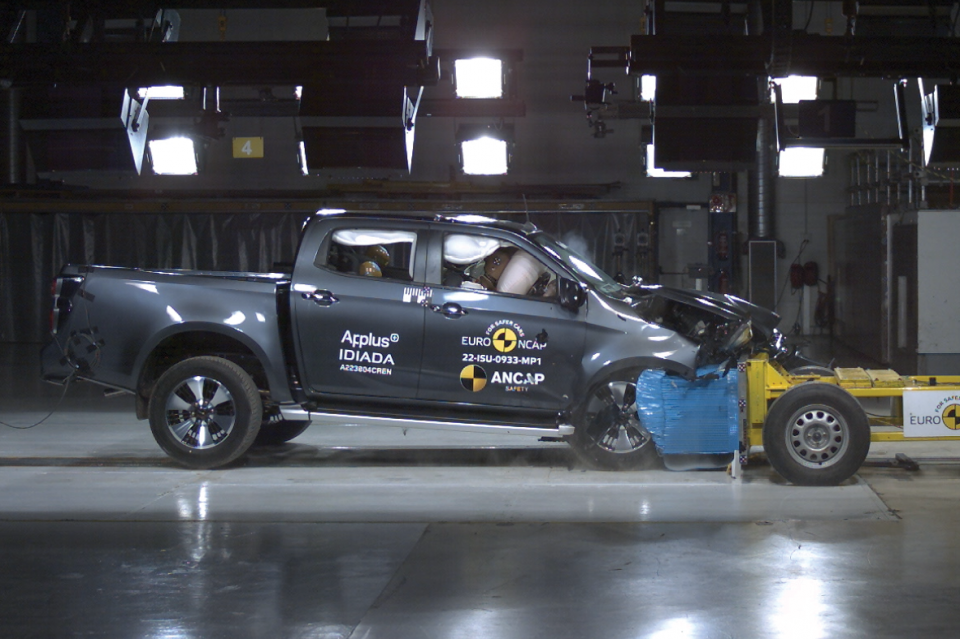
| Category | Mazda BT-50 | | — | — | |Adult occupant protection| 86 per cent | |Child occupant protection| 89 per cent | |Vulnerable road user protection| 67 per cent | |Safety assist| 84 per cent |
Even with their gleaming five-star safety badges earned in 2020, the utes faced a fresh round of scrutiny. Why? A subtle, yet significant, tweak to the D-Max and BT-50’s design: a redesigned driver’s knee airbag and instrument panel. It’s a testament to relentless improvement in vehicle safety.
Standard safety equipment includes:
- Autonomous emergency braking (AEB)
- Adaptive cruise control with stop and go
- Blind-spot monitoring
- Driver attention monitoring
- Lane-departure warning
- Lane-keep assist
- Rear cross-traffic assist
- Front parking sensors (GT and SP only)
- Rear parking sensors (pickup only)
- Reverse camera
- Traffic sign recognition
- Trailer sway control
To see how the Mazda BT-50 stacks up against its rivals, use ourcomparison tool
How much does the Mazda BT-50 cost to run?
Mazda backs the BT-50 with a reassuring five-year, unlimited-kilometre warranty, throwing in roadside assistance for the same duration. Just so you know, Isuzu Ute sweetens the deal a bit more, offering a six-year warranty capped at 150,000km.
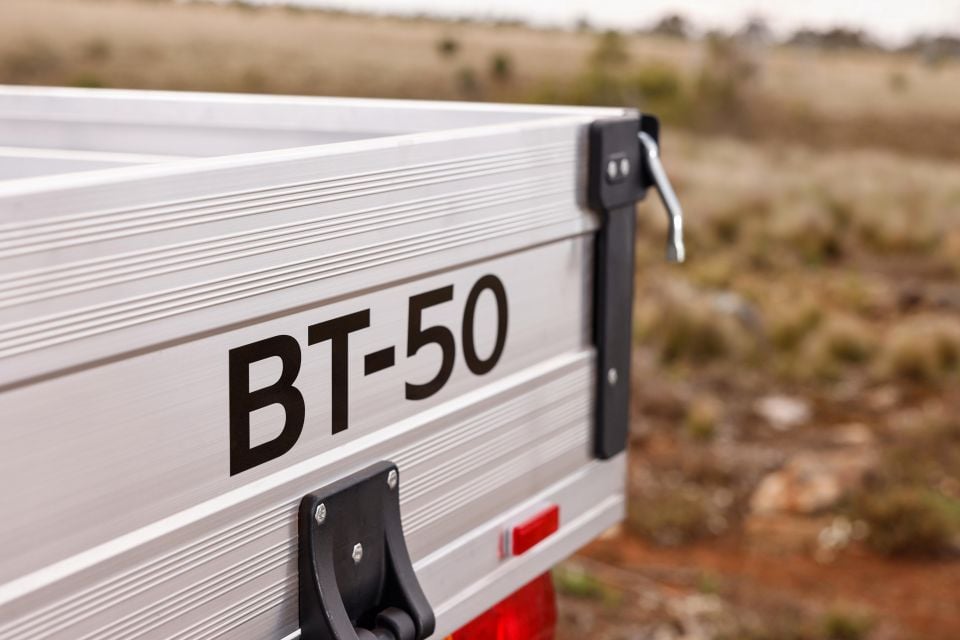
| Servicing and Warranty | Mazda BT-50 | | — | — | |Warranty| 5 years, unlimited kilometres | |Roadside assistance| 5 years, unlimited kilometres | |Service intervals| 12 months, 15,000km | |Capped-price servicing| 5 years | |Total capped-price service cost| $2188 (2.2L 4×2) $2302 (2.2L 4×4) $2406 (3.0L 4×2) $2496 (3.0L 4×4) | |Average annual service cost over 5 years| $437.6 (2.2L 4×2) $460.4 (2.2L 4×4) $481.2 (3.0L 4×2) $499.2 (3.0L 4×4) |
Individual capped-price service costs for each BT-50 drivetrain are outlined below.
| | 2.2L 4×2 | 2.2L 4×4 | 3.0L 4×2 | 3.0L 4×4 | | — | — | — | — | — | | 12 months or 15,000km | $392 | $449 | $416 | $458 | | 24 months or 30,000km | $422 | $422 | $423 | $425 | | 36 months or 45,000km | $560 | $560 | $729 | $731 | | 48 months or 60,000km | $478 | $535 | $499 | $541 | | 60 months or 75,000km | $336 | $336 | $339 | $341 |
Here’s the deal with keeping your Isuzu D-Max purring: your first five services will each set you back $469. Think of it as a five-year investment totaling $2345 – that gets you peace of mind, whether you’re rocking the standard or the high-powered engine.
Ford offers significantly cheaper servicing for the Ranger, with the first five services available for $1596 under a pre-paid plan.
Toyota HiLux owners, prepare for a pleasant surprise: the first six services come with a capped price of just $305 each. However, don’t let that initial affordability lull you into complacency. The HiLux demands attention every six months or 10,000km, meaning those seemingly inexpensive services add up to a grand total of $1830 in just three years. It’s a case of frequent, budget-friendly pit stops ultimately costing you more over the long haul.
To see how the Mazda BT-50 stacks up against its rivals, use ourcomparison tool
childcareman.xyz’s Take on the Mazda BT-50 XS
We went into Mazda’s launch expecting mild improvements, and fortunately our low-ish expectations were met.
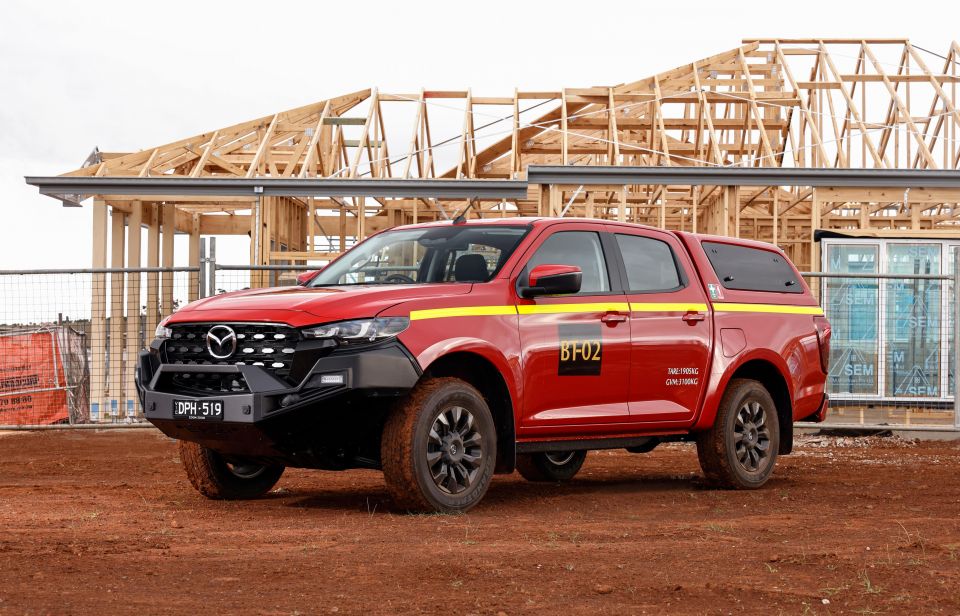
Forget fireworks, the base BT-50 is a steady simmer. It’s not going to blow your mind with performance, but it diligently executes its duties. Think reliable workhorse, not show pony. Nothing overtly excites, but equally, nothing dramatically disappoints.
Despite its merits, convincing buyers will be tougher than with the D-Max. The sting? A higher purchase price coupled with steeper short-term running costs. For fleet managers especially, that financial hurdle could be a deal-breaker – precisely the audience Mazda seems to be courting with these 2.2L trims, judging by their carefully curated promotional shots.
Ultimately, choosing between the BT-50 and its Isuzu counterpart can boil down to brand loyalty – that Mazda badge can be a powerful draw. Or perhaps the allure lies within the newly broadened XS range, making the decision a deliciously difficult dilemma driven purely by personal taste.
"In the budget-friendly ute showdown, both contenders have upped their game. If price reigns supreme, the D-Max emerges as the clear victor. But if your priorities extend beyond the price tag? Consider it a dead heat – flip a coin and you’ll still land on a winner."

childcareman.xyz can save you thousands on a new Mazda BT-50. Clickhereto get a great deal.
Click the images for the full gallery
Explore the Mazda BT-50 showroom
Thanks for reading 2026 Mazda BT-50 review